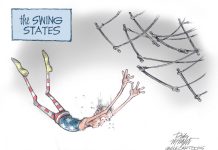Bloomberg Opinion
The slaughter at Robb Elementary School in Uvalde, Texas, has stunned a country tragically accustomed to mass shootings. Coming just days after the atrocity at Buffalo, New York, this latest outrage has strengthened calls for tighter gun laws. This time, perhaps, something might actually be done.
One approach looks especially promising. So-called red-flag laws — measures that allow police or family members to ask a court to intervene when someone poses a threat to himself or others — are commanding renewed bipartisan support. They aren’t infallible: Nothing could be in a country awash with guns. But more than half of mass shooters exhibited clear warning signs before committing their crimes, which makes such laws worthwhile. When it comes to gun control, the combination of efficacy and feasibility is rare. Policymakers should seize the moment.
Opponents of red-flag laws call them unfair because they lack due process. In truth, they’re no more burdensome than traditional domestic-protection laws, found in all 50 states. No one’s guns are taken away without a judge’s approval. If a temporary seizure is approved, another hearing is convened within weeks to allow the recipient of the order to offer a defense. In turn, the reporting parties must make their case for extending the order. The process isn’t foolproof but, given the stakes, it’s surely a fair one.
A more pressing concern is whether such laws really work. They’re now on the books of 19 states — including Indiana — but they’re relatively new, so it’s hard to be sure just yet. Still, the research so far is encouraging. In Connecticut, which enacted one of the first red-flag laws, a study estimated that one life has been saved for every 10 to 20 protection orders issued. A California study looked at 21 orders issued against individuals who’d made mass shooting threats and found no violence subsequently attributed to any of them.
It’s unclear to what extent the shooter in Uvalde was known to pose a threat before he began his attack. The Buffalo case also underlines the limits, because New York already had a red-flag law. The killer was known to the authorities and had been subject to a mental-health evaluation. Upon release, with no extreme-risk protection order issued, he was able to go out and buy the murder weapon. Exactly what went wrong is being investigated.
Officials will never be clairvoyant. Mistakes will be made. Yet red-flag laws have real potential. In the US, public opinion and the courts constrain what can be done, so policymakers have to make the best of imperfect solutions. Whether red-flag laws are advanced state by state, or by action in the US Congress, the benefits will outweigh the drawbacks. After the horrors of Buffalo and Uvalde, there’s no excuse for failing to act.




